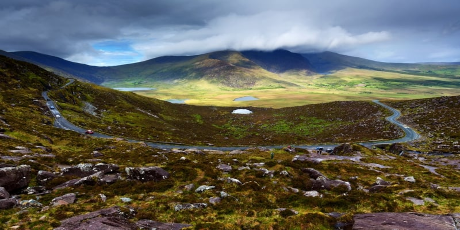Conor Pass: 'a blank slate for rewilding' 26 Apr 2024

Opinion: The new national park is an opportunity to think big and see the connections between different parts of the landscape - Dr. Markus Eichhorn is a lecturer in the School of Biological, Earth and Environmental Sciences/Environmental Research Institute at UCC
Ireland is undertaking a genuine innovation in conservation practice. Today’s announcement of the State's newest and largest national park in Kerry, Páirc Náisiúnta na Mara, Ciarraí, includes the purchase of the Conor Pass, following a national campaign and petition. The scenery is certainly spectacular but its value for conservation is largely in what it might one day become, rather than for anything it currently holds.
The landscape of the Conor Pass bears the scars of countless generations of livestock grazing. This has left scarcely any native vegetation in place. What we are being offered is effectively a blank slate for rewilding. Returning a large stretch of the Irish countryside to nature should be the cause of celebration, but is also a largely untested approach, with an uncertain end point.
Some advocates of rewilding take the purist perspective that we should let nature take its course. A long-standing assumption holds that 'natural’ is what happens when humans walk away. Unfortunately we know exactly what this will create, which is a paradise for invasive species.
If the Conor Pass becomes another tract of Rhododendron from which unchecked herds of Sika deer emerge to graze all else into oblivion then we will have gained nothing. Averting this outcome will require long-term, active management, at a recurrent and permanent cost to the State. Fencing and exclusion at this scale is effectively impossible which means culling and cutting. This is a return to nature by force if necessary.
Restoration is a noble objective, and the Conor Pass would likely be covered in a dense tangle of broad-leaved forests had humans never arrived on this island. Conjuring this is a feat of pure imagination because nothing like it exists in Ireland today except as sparse fragments.
It’s also a state that was only ever transient. Ireland was covered in glaciers and ice sheets for the majority of the last 2.6 million years. During interglacial periods, forests would have returned, but were the dominant vegetation for less than a tenth of the time. The landscape we have now has developed alongside people who arrived on foot around the same time as the trees, long before Ireland was even an island. A wild Irish rainforest in Kerry is a dream of possibility, but not an original state.
It would be misleading to call this restoration and, more importantly, it’s impossible because there are three insurmountable barriers. One is that the climate is shifting rapidly to conditions that barely resembles those of our childhood, never mind the weather that our forebears might have encountered. Warmer, wetter winters with stronger winds will flip to to hotter, drier summer months. Any trees that establish now will reach maturity in a very different world.
Even were it possible to return the climate of the past, we can’t bring back the species. Ireland lacks both the larger beasts of our pre-history and many of the plants of then too. In living memory, we have shed elm and ash, two central components of broad-leaved forests. While these trees will one day return, it will not be within our lifetimes. Our pool of native species is depleted. Should we allow or introduce exotic species adapted for the climate of the future? This is a step too far for most conservation practitioners.
We also can’t ignore the land itself. Thousands of years of heavy grazing and erosion have exposed rocks and forced retreat of the vegetation onto patches of ever-thinning soils. The deep, rich, complex soil of a natural forest cannot be replaced other than by the same long process of development that took place when the glaciers first retreated. Do we have the patience to wait thousands of years for this to happen again?
Finally, is forest even what people want? We have so grown accustomed to a cultural landscape of open views across bleak rocks that we now believe this to be wild. One seldom acknowledged problem of forests is that they block the view. Regenerating forests are dense, messy and impenetrable. They sound nice in principle but are aesthetically pleasing only from a distance.
A national park which makes ongoing demands on the exchequer has to appeal to the public as its ultimate owners and sponsors. We could of course retain the Conor Pass as it is today, though this would be a missed opportunity, and sheep farming is no less reliant on subsidy than conservation.
What is our vision for the Irish countryside - and what will it take to achieve it?
Ultimately the greatest value of the Conor Pass is likely to be downstream, where the new national park extends through lakes and rivers into the sea and offshore islands. It is this capacity to control and manage a whole watershed that provides its most distinctive feature. Purchasing the Conor Pass was worth it for this alone because any action taken lower down would have been contingent on the whims of whoever owned the uplands. Páirc Náisiúnta na Mara Ciarraí gives us an opportunity to think big and see the connections between parts of the landscape instead of treating any single element in isolation.
We own the Conor Pass now as opportunity, responsibility and burden. The purchase price is almost irrelevant because the true cost will be the investment to which we have collectively committed. Conservation science can’t tell us what to do next because this is uncharted territory. What is our vision for the Irish countryside - and what will it take to achieve it?